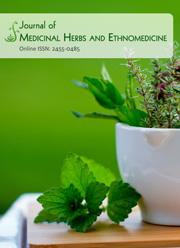Ultrasound assisted extraction of pectin from Trachystemon orientalis L.
DOI:
https://doi.org/10.25081/jmhe.2019.v5.5286Keywords:
Pectin, Trachystemon orientalis L, Nanobead, SEM, FT-IR, TGAAbstract
Pectin, a natural bio polymer, has wide range of applications in different fields because of its gelling, stabilizing and emulsifying ability as food additive/preservative and drug carrier etc. Main objective of this study was to describe the extraction of pectin for the first time from Trachystemon orientalis L., a medicinal plant grown in black sea region of Turkey. Pectin was extracted from the plant by ultrasound assisted acid hydrolysis method. Obtained pectin was characterized by using ATR-FT-IR and TGA methods. It was observed that the plant contained 2.5% pectin (0.25 g pectin/ per 10 g dried sample). Obtained pectin was labeled as High Methyl esterified Pectin (HMP) as its methoxyl- content was found to be 80% by using titrimetric method. ATR-FT-IR and TGA images were obtained as well. It can be concluded that Trachystemon orientalis L. could be a new source for pectin production for food and pharmaceutical industries.
Downloads
References
[2]. Akçin, Ö.E., Kandemir, N., Akçin, Y. A morphological and anatomical study on a medicinal and edible plant Trachystemon orientalis (L.) G.Don (Boraginaceae) in the Black Sea Region. Turkish Journal of Botany. 2004;28:435-442.
[3]. Petrova I, Petkova B, Kyobashieva B, Denev B, Simitchiev C, Todorova B, Dencheva B. Isolation of pectic polysaccharides from Celery (Apium graveolens var. rapaceum D. C.) and their application in food emulsions. Turkish Journal of Agricultural and Natural Sciences Special Issue: 2014;1818-1824.
[4]. Liu L, Cao J, Huang J, Cai Y, Yao J. Extraction of pectins with different degrees of esterification from mulberry branch bark. Bioresource Technology. 2010;101:3268–3273.
[5]. Bayar N, Bouallegue T, Achour M, Kriaa M, Bougatef A, Kammoun R. Ultrasonic extraction of pectin from Opuntia ficus indica cladodes after mucilage removal: Optimization of experimental conditions and evaluation of chemical and functional properties. Food Chemistry. 2017;235:275-82.
[6]. Alici EH, Arabaci G. Purification of polyphenol oxidase from borage (Trachystemon orientalis L.) by using three-phase partitioning and investigation of kinetic properties. Int J Biol Macromol. 2016;93:1051-1056.
[7]. Kibar B, Kibar H. Determination of the nutritional and seed properties of some wild edible plants consumed as vegetable in the Middle Black Sea Region of Turkey. South African Journal of Botany. 2017;108:117-25.
[8]. Uzun E, Sariyar G, Adsersen A, Karakoc B, Gulten Ö, Oktayoglu E, Pirildar S. Traditional medicine in Sakarya province (Turkey) and antimicrobial activities of selected species. Journal of Ethnopharmacology. 2004;95:287–296.
[9]. Polat R, Cakilcioglu U, Kaltalio?lu K, Ulusan MD, Türkmen Z. An ethnobotanical study on medicinal plants in Espiye and its surrounding (Giresun-Turkey). Journal of Ethnopharmacology. 2015;163:1–11.
[10]. Onaran A, Y?lar M. Antifungal Activity of Trachystemon orientalis L. Aqueous Extracts against Plant Pathogens. Journal of Food, Agriculture & Environment. 2012;10(3&4):287-291.
[11].Ayvaz CM. Antioxidant activity of Trachystemon orientalis (L.) G. Don (Borage) grown and eaten as food in Ordu, Turkey. Herba Polonica, 2015;61(4):40-51.
[12]. Koca AF, Koca I, Anil M, Hasbay I, Yilmaz VA. Physical, rheological and sensory properties of Tarhana prepared with two wild edible plants (Trachystemon orientalis (L.) G. Don) and (Portulaca oleracea L.). Journal of Food Process Technology. 2015;6:443-450.
[13]. Filippov MP., Shkolenko GA., Kohn R. Determination of the esterification degree of the pectin of different origin and composition by the method of infrared spectroscopy, Chem. Zvesti, 1978;32(2):218-222.
[14]. Tiwari AK, Saha SN, Yadav VP, Upadhyay UK, Katiyar D, Mishra T. Extraction and characterization of pectin from orange peels. International Journal of Biotechnology and Biochemistry. 2017;13(1):39-47.
[15]. Anthon GE & Barrett DM. Combined enzymatic and colorimetric method for determining the uronic acid and methylester content of pectin: Application to tomato products. Food Chemistry. 2008;110:239–247.
[16]. Willats WGT, Knox JP, Mikkelsen JD. Pectin: New insights into an old polymer are starting to gel. Trends in Food Science and Technology. 2006;17:97-104.
[17]. Srivastava P and Malviya R. Sources of pectin, extraction and its applications in pharmaceutical industry, An overview. Indian Journal of Natural Product and Resources. 2011;2(1):10-18.
[18]. Xu SY, Liu JP, Huang X, Du LP, Shi FL, Dong R, et. al. Ultrasonic-Microwave assisted extraction, characterization and biological activity of pectin from jackfruit peel. LWT-Food Science and Technology. 2018;90:577–582.
[19]. Fellah A, Anjukandi P, Waterland MR, Williams MAK. Determining the degree of methylesterification of pectin by ATR/FT-IR: Metodology optimisation and comparison with theoretical calculations. Carbohydrate Polymers. 2009;78:847-853.
[20]. Fasoli M, Dell’Anna R, Dal Santo S, Balestrini R, Sanson A, Pezzotti M, et. al. Pectins, hemicelluloses and celluloses show specific dynamics in the internal and external surfaces of grape berry skin during ripening. Plant Cell Physiology. 2016;57(6):1332–1349.



 .
.